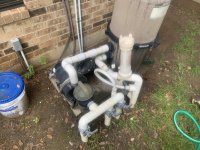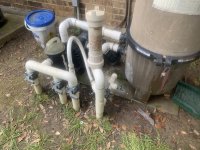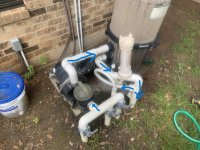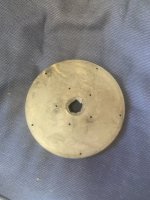Our pool that came with our house had a broken Pool Cleaner (Polaris 380) and Booster Pump (Polaris PB4-60). Knowing how to manually clean a pool and no idea how to fix a pool cleaner, I tossed the cleaner in storage. Fast forward a year when manually cleaning is losing its luster, I discover that the cleaner is actually a very good one and fix it. I set it up and it runs for about an hour and stops moving. Find out that the booster pump is not working properly, and investigating a rattling sound reveals a broken impeller (middle is completely broken off).
This pump is likely around 10 years old, but it hasn't been used at all in the last year. And when it was used last, the cleaner didn't even work properly (broken belt, among other things).
I am thinking that the pump broke due to excess strain (well, obviously, but let me continue). I have 2 filters on the 380: a small one at the wall quick connect and another longer in-line one (that is likely not doing anything as the previous filter is before it). The pool is very dirty at present, and this small filter is filling up fast. When the cleaner stopped moving (impeller broke) I checked this filter and it was covered over with debris...
Prior to fixing the the 380, the previous small filter had a hole in it, and there was no in-line filter...
Last thing to note is the intake line for the booster pump has a crack in it (air getting in). Just now discovered and repairing.
This pump is likely around 10 years old, but it hasn't been used at all in the last year. And when it was used last, the cleaner didn't even work properly (broken belt, among other things).
I am thinking that the pump broke due to excess strain (well, obviously, but let me continue). I have 2 filters on the 380: a small one at the wall quick connect and another longer in-line one (that is likely not doing anything as the previous filter is before it). The pool is very dirty at present, and this small filter is filling up fast. When the cleaner stopped moving (impeller broke) I checked this filter and it was covered over with debris...
Prior to fixing the the 380, the previous small filter had a hole in it, and there was no in-line filter...
Last thing to note is the intake line for the booster pump has a crack in it (air getting in). Just now discovered and repairing.
- Is this normally enough strain to kill an impeller (either the filter clogging, air getting in, or both)?
- Should I remove this small filter and use the larger filter until the pool reaches a cleaner state?
Just trying to understand why this impeller broke before I install a new one. Thank you!





